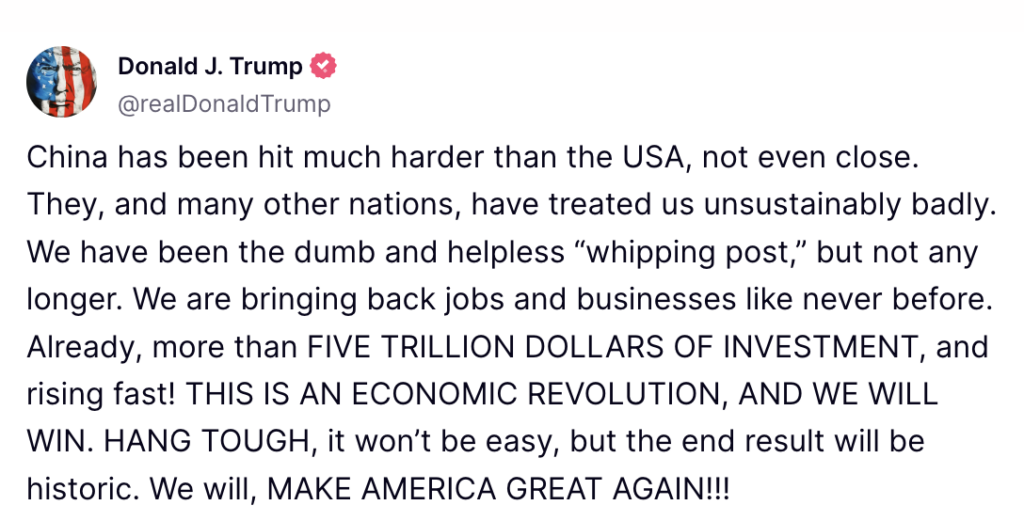Stock Market Declines Prompt Review of President Trump’s Impact
For over a century, stocks have been the highest-performing asset class, delivering greater average annual returns than any other. However, the market does not move in a linear fashion. Recently, the iconic Dow Jones Industrial Average (DJINDICES: ^DJI), significant S&P 500 (SNPINDEX: ^GSPC), and growth-oriented Nasdaq Composite (NASDAQINDEX: ^IXIC) have declined over the past six weeks.
Where to invest $1,000 right now? Our analyst team just revealed what they believe are the 10 best stocks to buy right now. Learn More »
Since reaching its all-time closing high on February 19, the Dow Jones, S&P 500, and Nasdaq Composite have fallen by 9.2%, 12.2%, and 17.5%, respectively. The S&P 500 and Nasdaq’s double-digit declines place them firmly in correction territory, while the Dow is not far behind.

President Trump giving remarks on his Liberation Day tariffs. Image source: Official White House Photo.
The recent declines are surprising after a strong finish at the end of President Donald Trump’s first term. On January 20, 2021, the Dow, S&P 500, and Nasdaq Composite had recorded gains of 57%, 70%, and 142%, respectively. Trump’s policies that favored deregulation and a lower corporate tax rate painted an image of continued growth for investors. However, in his first two months in office, the market’s performance has raised concerns.
President Trump Sets Unfortunate Stock Market Record
Stock market corrections are normal and necessary for a healthy investment cycle. They often serve as a price to pay for long-term asset growth. Each president has typically faced a market correction during their tenure, but President Trump has made headlines for overseeing the quickest 10% downturns from a 52-week high in the S&P 500 since 1950.
According to aggregated data from Bloomberg by independent financial research firm Fundstrat, the fastest 10% corrections in the S&P 500 over the past 75 years are:
- Feb. 19, 2020 to Feb. 27, 2020 (8 calendar days) / President Donald Trump.
- Jan. 26, 2018 to Feb. 8, 2018 (13 calendar days) / President Donald Trump.
- June 12, 1950 to June 29, 1950 (17 calendar days) / President Harry S. Truman.
- Sept. 23, 1955 to Oct. 11, 1955 (18 calendar days) / President Dwight D. Eisenhower.
- Feb. 19, 2025 to March 11, 2025 (20 calendar days) / President Donald Trump.
While the most recent decline of 10% over a period of 20 calendar days matches the experience of Presidents Bill Clinton and Jimmy Carter, Trump remains the only president who has managed three double-digit percentage declines in under 20 calendar days. Although the downturn in February 2020 was exacerbated by the COVID-19 pandemic, the declines seen in 2018 and 2025 directly connect back to Trump’s administration. The 2018 downturn stemmed from fears of escalating inflation and rising interest rates. The current market correction appears to be linked to investor concerns over Trump’s “Liberation Day” tariff decisions.
On April 2, Trump revealed a comprehensive list of tariffs targeting countries with trade imbalances against the U.S. These tariffs affect key nations for technology and retail sectors. As a result, the Atlanta Fed’s GDPNow model now forecasts a contraction of 2.8% in first-quarter gross domestic product (GDP), according to its April 3 update.
Given the current market situation, compounded by Trump’s inherited high asset valuations, the recent declines in the S&P 500 and Nasdaq Composite were perhaps inevitable.

Image source: Getty Images.
Market Declines: A Chance for Long-Term Investors
While many investors may be disheartened by President Trump’s tariff policies and the market’s initial response to his second term, the recent declines in the Dow Jones, S&P 500, and Nasdaq Composite present a valuable opportunity for long-term investors.
As previously mentioned, stock market corrections are an expected and healthy part of investing. These emotional downturns cannot be completely avoided through fiscal or monetary policy. Instead, it’s crucial to maintain perspective and remember the broader trends over time.
In June 2023, researchers at Bespoke Investment Group released a comparison of bull and bear market lengths in the S&P 500, tracing back to the beginning of the Great Depression. This analysis highlighted the stark contrast between the durations of bull and bear markets.
On average, bear markets lasted 286 calendar days (approximately 9.5 months) since September 1929, while typical bull markets lasted 1,011 calendar days, or about two years and nine months. This cyclical nature reaffirms the notion that market corrections often serve as prime opportunities for long-term investors.
It’s official. A new bull market is confirmed.
The S&P 500 is now up 20% from its 10/12/22 closing low. The prior bear market saw the index fall 25.4% over 282 days.
Read more at https://t.co/H4p1RcpfIn. pic.twitter.com/tnRz1wdonp
— Bespoke (@bespokeinvest)
Historical S&P 500 Returns Demonstrate Long-Term Investment Viability
Recent research from Crestmont Research highlights the importance of time and perspective in investing. The study evaluated the rolling 20-year total returns (including dividends) of the S&P 500, tracing data back to 1900. While the S&P 500 was officially created in 1923, researchers harnessed data from its component stocks in other major indexes to capture performance insights starting at the dawn of the 20th century. This analysis produced a total of 106 rolling 20-year periods, from 1900 to 1919, 1901 to 1920, and continuing up to 2004 to 2005.
The results from Crestmont indicate that every one of the 106 timelines yielded a positive annualized total return. In simpler terms, if an investor had purchased an S&P 500 tracking index at any point between 1900 and 2005 and held that investment for 20 years, they would have accrued profits consistently. This outcome was observed regardless of external factors such as changes in presidential policies, wars, pandemics, market crashes, or bear markets. The S&P 500, including dividends, has proven to be resilient, never decreasing over a 20-year span.
Is Now the Right Time to Invest $1,000 in the S&P 500 Index?
Before proceeding to invest in the S&P 500 Index, it is prudent to evaluate this:
The Motley Fool Stock Advisor analyst team recently pinpointed what they consider the 10 best stocks for current investment, notably excluding the S&P 500 Index. The selected stocks are projected to yield significant returns in the upcoming years.
For example, when Nvidia was included in their recommendations on April 15, 2005, a $1,000 investment at that time would have grown to an impressive $578,035!*
The Motley Fool Stock Advisor offers investors a structured approach to wealth-building with insights on portfolio development, regular updates from analysts, and two new stock picks each month. Since 2002, this service has more than quadrupled the returns of the S&P 500.* Be sure to check out the latest top 10 stock list available with your membership in Stock Advisor.
*Stock Advisor returns as of April 5, 2025
Sean Williams has no position in any of the stocks mentioned. The Motley Fool has no position in any of the stocks discussed. The Motley Fool adheres to a disclosure policy.
The views and opinions presented here are those of the author and do not necessarily reflect the stance of Nasdaq, Inc.



